Kona Wah Wah 2 Plastic Flat Pedal
| Where To Buy | |||
|---|---|---|---|
Free shipping on orders over $50 (continental U.S. only).
International shipping available. Some exclusions apply. |
|||
Free shipping on orders over $50 (continental U.S. only).
International shipping available. Some exclusions apply. |
|||

Legend is a term that should never be thrown about lightly, but in the case of Kona’s original Wah Wah flat pedal it’s not a stretch to invoke the L word to cement its status among the pedals that have left their mark in the history books of the sport – not to mention on a shin or two! When the Wah Wah hit the market, over ten years ago now, it was flatter, thinner, and grippier than most of the other options out there. It may not look all that exciting by today’s standards, but when it was released it instantly relegated all the thicker, clunkier pedals to yesterday’s news. Cherry on the cake, it was about as durable as they come as well. Fast forward to 2018, and v2 of the Wah Wah is here. Curious to see how it would stack up in a market that looks nothing like it did in 2007 or so, we’ve had a pair out on the trails for some early impressions.
Kona Wah Wah 2 Highlights
- Glass-fiber reinforced, nylon composite body
- 118x120mm platform
- 14 replaceable pins per pedal
- Steel spindle
- Fully serviceable bearing system
- Colors: Black, Forest Green, Orange, Purple, Red, Slime Green
- Weight: 354 grams (verified)
- MSRP: $59.99
Initial Impressions
The flat pedal world is a different place today than it was when the original Wah Wah was designed. Fittingly, the Wah Wah 2 bears no resemblance to its forefather, least of all when it comes to the material used. Yes, Kona has chosen a composite pedal body for the rebirth of the Wah Wah, which might seem like a curious choice at first. With light weight and a low price tag as the main benefits, the recent increase in the number of pedals made from this material is easy to understand. However, won’t most people probably still prefer an alloy pedal? Probably yes, and we have strong reason to believe that Kona will have the aluminum version of the Wah Wah 2 ready pretty soon as well, but for now, glass fiber reinforced nylon is what is on offer.




The body of the Wah Wah 2 is both wide and flat. In fact, when you look at the measurements in detail, it’s right up there with the absolutely biggest pedals available today. When compared to the 17 other flat pedals tested as part of our recent flat pedal Face Off feature, the Wah Wah 2 boasts the longest Axle-To-Pin measurement of them all. It’s also among the thinnest, while retaining a good concavity score (which we have found to be a crucial factor when it comes to grip). Here are the key dimensions to give you the whole picture:
Width | Length | Thickness (at thickest) | Thickness (with pins) | Weight | Pin-To-Axle (PTA) |
118mm | 120mm | 18mm | 22mm | 354 grams | 119mm |
Kona went with a bearing-based axle system for the Wah Wah 2, which means that they needed a somewhat large inboard bulge to accommodate the bigger, inboard bearing. The bearings can all be easily replaced by the average home mechanic, which of course is good news for longevity. The same goes for the rear-loading pins, which can be removed and replaced even if you snap the pins off flush with the pedal surface. The leading edges are heavily chamfered, to help the Wah Wah 2 glance off obstacles as opposed to hang up on them. All this bodes very well for performance on the trail.




On The Trail
There’s not much to tell about installing the Wah Wah 2 on the bike, other than to point out that it will require a pedal washer in most cases due to the design of the inboard bearing bulge which sits very close to the crank arm. The pedal spun freely out of the box, with no discernable play in the axle at all.


We’re always slightly apprehensive of composite pedals, as our experience shows them to be less outright grippy than a metal pedal, all other things being equal. Sure, most of a pedal’s grip is generated by the pins, but with these bigger and more open designs, the sole of the shoe will sink into the pedal and generally come in contact with the actual pedal body at some point – and when that happens, plastic is often more slippery than machined alloy. The Wah Wah 2 features only seven pins per side, placed all around the three outer edges of the pedal body, which leaves the whole inside/center area open to contact with the shoe. Thankfully, the concavity on offer is more than enough to offset any plastic slipperiness, and the result is very good grip in all conditions with a nice, locked-in feel.

With one of the largest platforms we’ve tested, our feet were properly supported on the Wah Wah 2 no matter where we’d happen to put them down. And as long as we kept our heels down, they would stay there too. Note that if you like to place your feet as close to the crank arm as possible, the bearing bulge of the Wah Wah 2 will eventually get in your way. Other than that, the pedal feels very solid, although as with most composites, there seems to be a tiny amount of “give” in the body. It’s not flexy per se of course, there is just something less “direct” about how they feel when you slap your foot down on them. Some people might even prefer this feeling. Be that as it may, we’ve had the pedal out on several different types of rides already, with the same good results whether it’s charging a rock garden or hitting a drop.

Comparing the composite Wah Wah 2 to the winners in our flat pedal Face Off, we’d probably give them an 8 in the “grip” score, leaving the pedal somewhere in the upper tier thanks to a strong performance when it comes to weight and physical dimensions. If there is an alloy version on the horizon, it can probably do a bit better than that, which would see it challenge for the podium – time will tell!
Things That Could Be Improved
At $59.99, there really is not much to complain about here. Yes, we do ultimately prefer alloy pedals, but we’re not going to hold that against this composite version, which delivers a great new platform shape and excellent on-trail manners. We would have liked to see a couple of spare pins in the box, not because of their cost but because of the convenience of having a couple on hand when and if one breaks.
Long Term Durability
The original Wah Wah was one of the more durable pedals we’ve known, so the bar is set high for this new version. After we finished the initial testing of the new pedals, we gave them to a friend who rides 4 times per week, and who loves rocky terrain. After 7 months of heavy use, he reports that he has managed to snap a couple of pins - in all cases they snapped clean, leaving the little nut in the pedal body unharmed. Since the pins are rear-loading, they've been very easy to replace. Other than that, there's hardly any play detectable in the bearings and bushings at all, and the main pedal body is still going strong, so it certainly looks like high marks for longevity are in order as well. The pedals are fully serviceable, and the bushings and bearings can all be easily replaced when the time comes. In general terms, composite pedals can be a bit more brittle than their alloy counterparts over time (2 years+), which is something to take into consideration here.
What’s The Bottom Line?
Coming up with a new version of a very successful product is always a daunting task, but the truth of the matter is that the Wah Wah 2 has little in common with its ancestry – and with good reason. The flat pedal world has moved on since then, and so has Kona. The new pedal is perfectly up to date in regards to its shape, while retaining the easily serviceable bearing system that helped the old version achieve a convincing durability track record. Kona chose to launch this new pedal in a composite version first, which sees it produce a very competitive product at a great price. We’re fans of how it feels on the trail, and for $59.99 it is definitely one of the very best composite options out there right now. Also check out the alloy version for an even radder option!
More information at: www.konaworld.com.
About The Reviewer
Johan Hjord - Age: 44 // Years Riding MTB: 12 // Weight: 200-pounds (90.7kg) // Height: 6'0" (1.84m)
Johan loves bikes, which strangely doesn’t make him any better at riding them. After many years spent practicing falling off cliffs with his snowboard, he took up mountain biking in 2005. Ever since, he’s mostly been riding bikes with too much suspension travel to cover up his many flaws as a rider. His 200-pound body weight coupled with unique skill for poor line choice and clumsy landings make him an expert on durability - if parts survive Johan, they’re pretty much okay for anybody. Johan rides flat pedals with a riding style that he describes as "none" (when in actuality he rips!). Having found most trail features to be not to his liking, Johan uses much of his spare time building his own. Johan’s other accomplishments include surviving this far and helping keep the Vital Media Machine’s stoke dial firmly on 11.
Photos by Johan Hjord
2 member reviews
I first learned of the Wah Wah 2's when I was researching Catalyst pedals. I've been riding flats exclusively for over 15 years and wanted a wider platform for more power and support. As a lighter rider (145lbs, 150-155 kitted up) and somewhat of a weight weenie, I didn't want the weight penalty of a 500g pedal. Enter the Wah Wah 2.
At 360 grams for the composite version, it had everything I was looking for - a large and wide concave platform, thin profile, light weight, a good amount of pins and half the cost of most alloy pedals in this class. The pedals are 120 x 118 x 13 mm thick. At the time I purchased them the aluminum versions weren't available yet, which made my decision to try these much easier. I was a little wary of stories about composite pedals shattering and pins shearing but in my experience I had little to worry about.
These pedals simply excel for their intended purpose. I've used them on my trail/AM bike for several months now, riding in the wet and mucky PNW. I've had several rock strikes, a few crashes, and they've been holding up fine. No lost pins or worn bearings and they're spinning as smooth as the day I bought them.
On the trail they provide plenty of grip. I ride 510 Freeriders, and I've never lacked for grip, even in the rain and mud. In fact, I have to almost pull my feet completely off the pedals to readjust, the grip is that good. The wide platform allows me to ride with my foot in a more centered position and these pedals still offer plenty of support. I wear a 8.5/41 size shoe for reference. Obviously, larger feet will not have the same degree of this benefit.
Conclusion: For $60 and at a lighter weight than the alloy version, this pedal seems like an obvious choice. For me there's nothing the aluminum version offers over these except a little more bling.
0 comments
Post a reply to: Wide and Light flat pedal at a great price
Pins (grip)
Comfort of platform shape
Price
Thinness
Really nice . First time I’ve gone plastic (weight and price). Replaced some twice price uncomfortable HT AE03 Alloy Pedals which felt horrible and the bearings/bushings didn’t hold up.
0 comments
Post a reply to: Really comfy grippy cheap pedals
Specifications
| Where To Buy | |||
|---|---|---|---|
Free shipping on orders over $50 (continental U.S. only).
International shipping available. Some exclusions apply. |
|||
Free shipping on orders over $50 (continental U.S. only).
International shipping available. Some exclusions apply. |
|||


















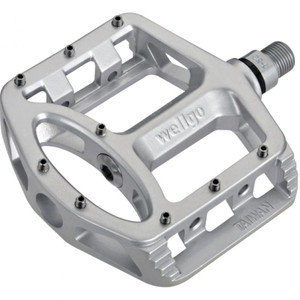
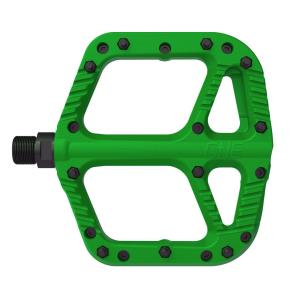

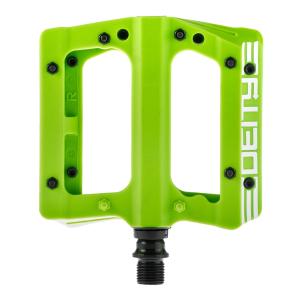
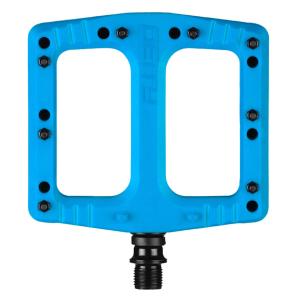

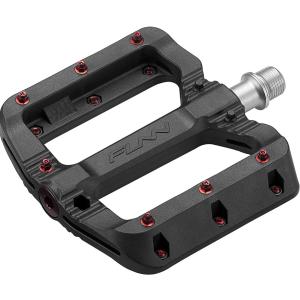
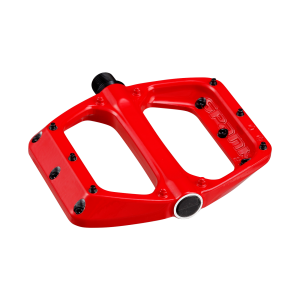









3 comments
Post a reply to: First Ride: Kona Wah Wah 2 Composite Pedal